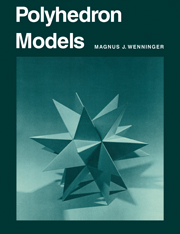Book contents
- Frontmatter
- Dedication
- Contents
- Preface to 1978 reprint
- Preface
- Foreword
- Introduction: uniform polyhedra
- Mathematical classification
- Section I The Convex Uniform Polyhedra: The Platonic and Archimedean Solids
- Section II Some Stellations and Compounds
- Commentary on stellations and compounds of the Platonic solids
- The stellated octahedron (19)
- Stellations of the dodecahedron (20–22)
- Commentary on the stellated icosahedron
- Stellations of the icosahedron (23–42)
- Commentary on the stellation of the Archimedean solids
- Stellations of the cuboctahedron (43–46)
- Commentary on the icosidodecahedron
- Stellations of the icosidodecahedron (47–66)
- Section III Non-convex Uniform Polyhedra
- Epilogue
- References
- List of models
Commentary on the icosidodecahedron
from Section II - Some Stellations and Compounds
Published online by Cambridge University Press: 05 August 2015
- Frontmatter
- Dedication
- Contents
- Preface to 1978 reprint
- Preface
- Foreword
- Introduction: uniform polyhedra
- Mathematical classification
- Section I The Convex Uniform Polyhedra: The Platonic and Archimedean Solids
- Section II Some Stellations and Compounds
- Commentary on stellations and compounds of the Platonic solids
- The stellated octahedron (19)
- Stellations of the dodecahedron (20–22)
- Commentary on the stellated icosahedron
- Stellations of the icosahedron (23–42)
- Commentary on the stellation of the Archimedean solids
- Stellations of the cuboctahedron (43–46)
- Commentary on the icosidodecahedron
- Stellations of the icosidodecahedron (47–66)
- Section III Non-convex Uniform Polyhedra
- Epilogue
- References
- List of models
Summary
The icosidodecahedron has twelve pentagons and twenty triangles as faces, a total of thirtytwo. This looks a formidable number to investigate. It will mean studying two stellation patterns, each composed of thirty lines.
As a first step to drawing the patterns it is worth noting that an icosidodecahedron is the solid that is common to a compound of a dodecahedron and an icosahedron. These patterns are already known. Those to be done now must therefore bear some resemblance and ought to serve as guides. So proceeding as for the stellated cuboctahedra you should be able to verify the two patterns given on the following pages.
These two stellation patterns lead to forty different kinds of cells. You would have to be exceptionally ambitious to verify this, so no more will be said about them here, except for this one brief remark. Just as the icosidodecahedral patterns include as a subset the lines of the dodecahedral and icosahedral patterns, so too the icosidodecahedral cells are building blocks for the dodecahedral and icosahedral cells. In other words these latter cells are further split up and subdivided by the extended facial planes of the icosidodecahedron.
The following polyhedra exhibit only a representative sub-set of stellated forms in this set. You will quickly notice that some of them are compounds or variations of the three stellated dodecahedra and/or some stellated icosahedron. This gives many of them the same beauty of form. But—the big question—are any uniform polyhedra to be found? The answer seems to be—no. Striking resemblances turn up, but none of them satisfies the definition of a uniform polyhedron.
As for finding regular polyhedra it has already been mentioned that the great mathematician Cauchy in 1811 proved that the four Kepler-Poinsot solids taken together with the five Platonic solids exhaust the list of regular polyhedra. So if you continue to look, you are merely joining the ranks of angle trisectors or circle squarers or cube duplicators.
For identification the models are numbered 47 to 66.
- Type
- Chapter
- Information
- Polyhedron Models , pp. 73 - 75Publisher: Cambridge University PressPrint publication year: 1971



